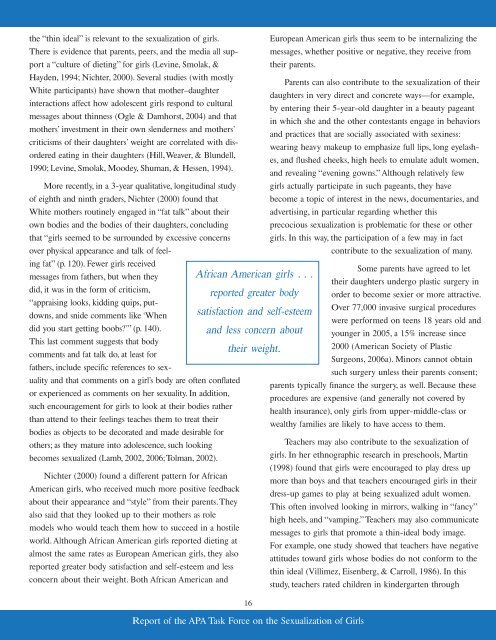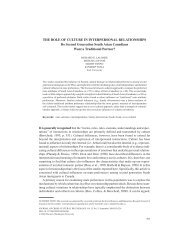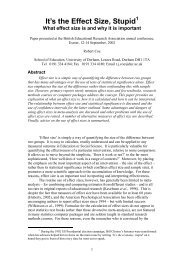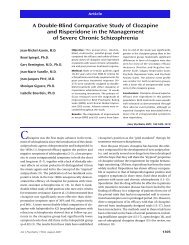SexualizationofWomen.. - Department of Psychology - York University
SexualizationofWomen.. - Department of Psychology - York University
SexualizationofWomen.. - Department of Psychology - York University
You also want an ePaper? Increase the reach of your titles
YUMPU automatically turns print PDFs into web optimized ePapers that Google loves.
the “thin ideal” is relevant to the sexualization <strong>of</strong> girls.<br />
There is evidence that parents, peers, and the media all sup-<br />
port a “culture <strong>of</strong> dieting” for girls (Levine, Smolak, &<br />
Hayden, 1994; Nichter, 2000). Several studies (with mostly<br />
White participants) have shown that mother–daughter<br />
interactions affect how adolescent girls respond to cultural<br />
messages about thinness (Ogle & Damhorst, 2004) and that<br />
mothers’ investment in their own slenderness and mothers’<br />
criticisms <strong>of</strong> their daughters’ weight are correlated with dis-<br />
ordered eating in their daughters (Hill,Weaver, & Blundell,<br />
1990; Levine, Smolak, Moodey, Shuman, & Hessen, 1994).<br />
More recently, in a 3-year qualitative, longitudinal study<br />
<strong>of</strong> eighth and ninth graders, Nichter (2000) found that<br />
White mothers routinely engaged in “fat talk” about their<br />
own bodies and the bodies <strong>of</strong> their daughters, concluding<br />
that “girls seemed to be surrounded by excessive concerns<br />
over physical appearance and talk <strong>of</strong> feel-<br />
ing fat” (p. 120). Fewer girls received<br />
messages from fathers, but when they<br />
did, it was in the form <strong>of</strong> criticism,<br />
“appraising looks, kidding quips, put-<br />
downs, and snide comments like ‘When<br />
did you start getting boobs?’” (p. 140).<br />
This last comment suggests that body<br />
comments and fat talk do, at least for<br />
fathers, include specific references to sex-<br />
uality and that comments on a girl’s body are <strong>of</strong>ten conflated<br />
or experienced as comments on her sexuality. In addition,<br />
such encouragement for girls to look at their bodies rather<br />
than attend to their feelings teaches them to treat their<br />
bodies as objects to be decorated and made desirable for<br />
others; as they mature into adolescence, such looking<br />
becomes sexualized (Lamb, 2002, 2006;Tolman, 2002).<br />
Nichter (2000) found a different pattern for African<br />
American girls, who received much more positive feedback<br />
about their appearance and “style” from their parents.They<br />
also said that they looked up to their mothers as role<br />
models who would teach them how to succeed in a hostile<br />
world. Although African American girls reported dieting at<br />
almost the same rates as European American girls, they also<br />
reported greater body satisfaction and self-esteem and less<br />
concern about their weight. Both African American and<br />
European American girls thus seem to be internalizing the<br />
messages, whether positive or negative, they receive from<br />
their parents.<br />
African American girls . . .<br />
reported greater body<br />
satisfaction and self-esteem<br />
and less concern about<br />
their weight.<br />
16<br />
Parents can also contribute to the sexualization <strong>of</strong> their<br />
daughters in very direct and concrete ways—for example,<br />
by entering their 5-year-old daughter in a beauty pageant<br />
in which she and the other contestants engage in behaviors<br />
and practices that are socially associated with sexiness:<br />
wearing heavy makeup to emphasize full lips, long eyelash-<br />
es, and flushed cheeks, high heels to emulate adult women,<br />
and revealing “evening gowns.” Although relatively few<br />
girls actually participate in such pageants, they have<br />
become a topic <strong>of</strong> interest in the news, documentaries, and<br />
advertising, in particular regarding whether this<br />
precocious sexualization is problematic for these or other<br />
girls. In this way, the participation <strong>of</strong> a few may in fact<br />
contribute to the sexualization <strong>of</strong> many.<br />
Some parents have agreed to let<br />
their daughters undergo plastic surgery in<br />
order to become sexier or more attractive.<br />
Over 77,000 invasive surgical procedures<br />
were performed on teens 18 years old and<br />
younger in 2005, a 15% increase since<br />
2000 (American Society <strong>of</strong> Plastic<br />
Surgeons, 2006a). Minors cannot obtain<br />
such surgery unless their parents consent;<br />
parents typically finance the surgery, as well. Because these<br />
procedures are expensive (and generally not covered by<br />
health insurance), only girls from upper-middle-class or<br />
wealthy families are likely to have access to them.<br />
Report <strong>of</strong> the APA Task Force on the Sexualization <strong>of</strong> Girls<br />
Teachers may also contribute to the sexualization <strong>of</strong><br />
girls. In her ethnographic research in preschools, Martin<br />
(1998) found that girls were encouraged to play dress up<br />
more than boys and that teachers encouraged girls in their<br />
dress-up games to play at being sexualized adult women.<br />
This <strong>of</strong>ten involved looking in mirrors, walking in “fancy”<br />
high heels, and “vamping.”Teachers may also communicate<br />
messages to girls that promote a thin-ideal body image.<br />
For example, one study showed that teachers have negative<br />
attitudes toward girls whose bodies do not conform to the<br />
thin ideal (Villimez, Eisenberg, & Carroll, 1986). In this<br />
study, teachers rated children in kindergarten through

















